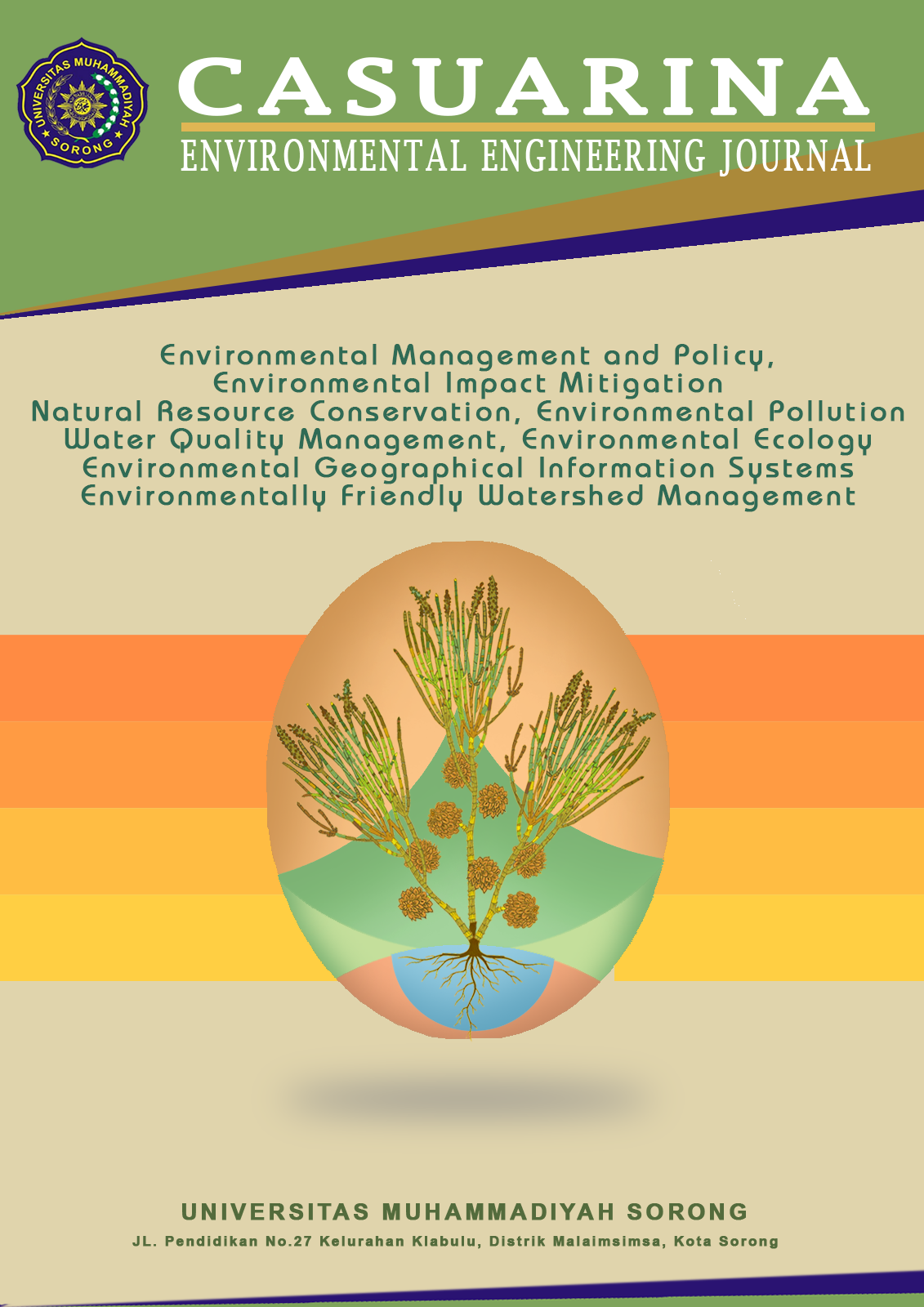Studi Evaluasi Sistem Drainase Di Kawasan Komplek Harapan Indah Kota Sorong Dengan Menggunakan Software EPA-SWMM 5.1
DOI:
https://doi.org/10.33506/ceej.v1i1.2859Kata Kunci:
Banjir, Drainase, EPA-SWMM,Harapan Indah, Kota Sorong.Abstrak
Kota Sorong adalah kota yang berkembang, dimana belakangan tahun terakhir ini sedang gencar melakukan pembangunan sarana dan prasarana disegala bidang. Beberapa pembangunan yang gencar dilakukan adalah pembangunan jalan dan pembangunan pemukiman perumahan. Kota Sorong khususnya daerah Komplek Harapan Indah merupakan salah satu daerah berkembang yang rawan sekali terjadi banjir maupun genangan lokal saat musim penghujan. Tujuan penelitian ini yaitu untuk mengetahui kondisi sistem drainase yang berada di harapan indah dalam menampung debit hujan maksimum untuk beberapa periode waktu tertentu. Metode penelitian yang digunakan adalah dengan melakukan pengolahan data yang didapat dari lapangan kemudian mengolahnya menggunakan software EPA-SWMM untuk mensimulasikan aliran drainase akibat limpasan permukaan yang terjadi. Dari hasil simulasi menggunakan software EPA-SWMM kondisi sistem drainase yang berada di daerah komplek Harapan Indah masih sering meluap, didapat dari hasil analisa saluran daerah di jalan Cendrawasih paling banyak meluap di periode ulang 2 tahun, 5 tahun & 10 tahun. Di Jalan Cendrawasih terdapat saluran yang meluap yaitu 18 saluran dengan perhitungan periode ulang 2 tahun, 24 saluran dengan perhitungan periode ulang 5 tahun dan 25 saluran dengan perhitungan periode ulang 10 tahun.
Referensi
Amri, Irman, Dkk, 2014. Pedoman Penulisan Tugas Akhir Bagi Mahasiswa Fakultas Teknik. Sorong : Fakultas Teknik Universitas Muhammadiyah Sorong.
Khoir, Rizki Ade, Dkk, 2015. Perencanaan Drainase Gayamsari Subsistem Kanal Banjir Timur Semarang.Jurnal. Semarang : Universitas Diponegoro.
Mulya, Rifki Adhi. 2017. Evaluasi Saluran Drainase Dengan Menggunakan Program Swmm 5.1 Di Perumahan De Bale Permata Arcadia, Depok, Jawa Barat. Bogor: IPB.
Pamudjianto, Agung. 2011. Buku Mata Kuliah Hidrologi. Sorong: Universitas Muhammadiyah Sorong.
Rossman, Lewis. 2015. Storm Water Management Model User’s Manual version 5.1. USA: U.S. Environmental Protection Agency.
Situmorang, Romorajausia. 2015. Penerapan Model EPA SWMM 5.1 untuk Evaluasi Saluran Drainase di Darmawangsa Residence, Bekasi, Jawa Barat. Bogor: IPB.
Suprapto, Mamok, Adi Yusuf M, Agelbilal Seretora Prilbista, (2018). Analisis Sistem Drainase Untuk Penanganan Genangan Di Kecamatan Magetan Bagian Utara. Jurnal. Magetan : Universitas Sebelas Maret.
Suprayogi, Imam, Dkk, 2017. Analisis Pengaruh Perubahan Tata Guna LahanTerhadap Saluran Drainase Jalan Dorak Berdasarkan Pola Rencana Tata Ruang Tata Wilayah Kabupaten Meranti Tahun 2013-2032 Menggunakan Model Epa Swmm 5.0. Jurnal. Pekanbaru : Universitas Riau.
Suripin. 2004. Sistem Drainase Perkotaan yang Berkelanjutan. Semarang: Andi.
Wesli. 2008. Drainase Perkotaan. Yogyakarta: Graha Ilmu.
Widyanarko, Eko Erly. 2015. Kajian Evaluasi Sistem Drainase (Jalan Cendrawasih Kecamatan Patrang Kabupaten Jember).Jurnal. Jember : Universitas Jember.
Unduhan
Diterbitkan
Cara Mengutip
Terbitan
Bagian
Lisensi
Hak Cipta (c) 2023 Casuarina: Jurnal Teknik Lingkungan

Artikel ini berlisensiCreative Commons Attribution-NonCommercial-ShareAlike 4.0 International License.
Please find the rights and licenses in Casuarina: Environmental Engineering Journal. By submitting the article/manuscript of the article, the author(s) agree with this policy. No specific document sign-off is required.
1. License
The non-commercial use of the article will be governed by the Creative Commons Attribution license as currently displayed on Creative Commons Attribution-NonCommercial-ShareAlike 4.0 International License.
2. Author(s)' Warranties
The author warrants that the article is original, written by the stated author(s), has not been published before, contains no unlawful statements, does not infringe the rights of others, is subject to copyright that is vested exclusively in the author, and free of any third party rights, and that any necessary written permissions to quote from other sources have been obtained by the author(s).
3. User/Public Rights
Casuarina: Environmental Engineering Journal's spirit is to disseminate articles published are as free as possible. Under the Creative Commons license, Casuarina: Environmental Engineering Journal permits users to copy, distribute, display, and perform the work for non-commercial purposes only. Users will also need to attribute authors and Casuarina: Environmental Engineering Journal on distributing works in the journal and other media of publications. Unless otherwise stated, the authors are public entities as soon as their articles got published.
4. Rights of Authors
Authors retain all their rights to the published works, such as (but not limited to) the following rights;
- Copyright and other proprietary rights relating to the article, such as patent rights,
- The right to use the substance of the article in own future works, including lectures and books,
- The right to reproduce the article for own purposes,
- The right to self-archive the article (please read our deposit policy),
- The right to enter into separate, additional contractual arrangements for the non-exclusive distribution of the article's published version (e.g., post it to an institutional repository or publish it in a book), with an acknowledgment of its initial publication in this journal (Casuarina: Environmental Engineering Journal).
5. Co-Authorship
If the article was jointly prepared by more than one author, any authors submitting the manuscript warrants that he/she has been authorized by all co-authors to be agreed on this copyright and license notice (agreement) on their behalf, and agrees to inform his/her co-authors of the terms of this policy. Sentralisasi will not be held liable for anything that may arise due to the author(s) internal dispute. Sentralisasi will only communicate with the corresponding author.
6. Royalties
Being an open accessed journal and disseminating articles for free under the Creative Commons license term mentioned, author(s) aware that Casuarina: Environmental Engineering Journal entitles the author(s) to no royalties or other fees.
7. Miscellaneous
Casuarina: Environmental Engineering Journal will publish the article (or have it published) in the journal if the article editorial process is successfully completed. Casuarina: Environmental Engineering Journal's editors may modify the article to a style of punctuation, spelling, capitalization, referencing, and usage that deems appropriate. The author acknowledges that the article may be published so that it will be publicly accessible and such access will be free of charge for the readers as mentioned in point 3.








